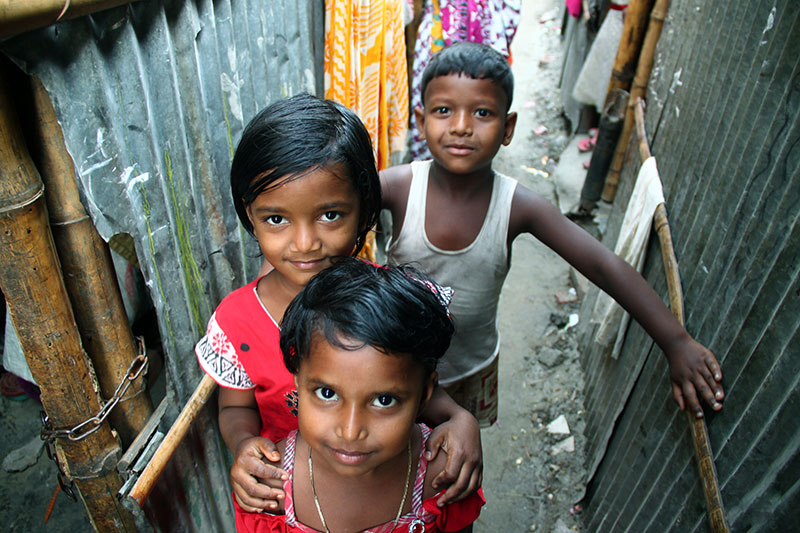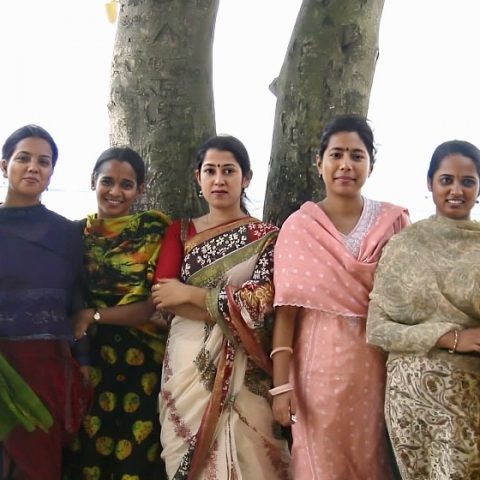Few images communicate the systemic poverty of the developing world as starkly as photos of wasting children. Scientifically, wasting is defined as a weight-for-height score that is two standard deviations below the WHO growth standard – but this dry, technical definition can hardly communicate the horror of children that have been undernourished to such an acute degree.

Children in urban slum in Bangladesh. Photo: Syed Hasibul Hasan / icddr,b
Severe childhood undernutrition is often associated with situations of catastrophic emergency, such as wars or environmental disasters. At the height of the conflict in Darfur, up to 22% of children in physically accessible areas were wasted, and more children die in these situations from wasting-induced diseases than from armed violence. These acute emergencies are very effective in capturing global attention, motivating the rapid delivery of much-needed humanitarian relief to prevent the loss of life from severe childhood undernutrition.
However, most deaths resulting from childhood undernutrition do not occur in situations of acute catastrophe. There is a popular stereotype that childhood wasting occurs primarily in Africa, in countries with unstable political regimes and a recent history of armed conflict. But the reality is very different. In 2003, 78% of the world’s estimated 5.5 million wasted children were found in India, Bangladesh and Pakistan – relatively stable nations that have all recently experienced a dramatic expansion in material prosperity. A more recent study from 2014 reported data showing that close to 20 million children suffer from severe acute malnutrition globally, with 8 million of them occurring in India alone.
The stereotypical view of wasted children as being a problem exclusive to famine-stricken, war-torn African countries is ultimately a myth. While war and environmental catastrophe certainly do lead to dramatic short-term elevations in childhood wasting, this is not the whole story. More work must be done to understand the persistence of childhood wasting in situations of relative political and economic stability.
Bangladesh has seen a significant reduction in the incidence of stunted and underweight children in the past 10 years, thanks to the successful efforts of national and international stakeholders in improving nutrition and health. Researchers at the International Centre for Diarrhoeal Disease Research, Bangladesh (icddr,b) have played a commanding role in these efforts. Indeed the success of Bangladesh in improving maternal and child health in the face of so many challenges has been so remarkable that it has been called the “Bangladesh paradox”.
However, in spite of all this progress, childhood wasting still persists at a level of 15%. Understanding the reasons for the stubborn persistence of severe childhood undernutrition in a situation of relative political stability and continued economic growth is a central question for global public health in the 21st century.
The public perception is that childhood wasting results primarily from lack of food, but this is not the only factor that can lead to stunted growth. Poor sanitation and hygiene can lead to repeated infections of the gut with faecal pathogens, leading to a condition of chronic inflammation and impaired intestinal function that is referred to as environmental enteropathy (EE). EE is highly prevalent in poor tropical countries with poor sanitation, but entirely absent in richer tropical countries like Singapore and Qatar. EE impairs the absorptive abilities of the gut, and has been associated with childhood stunting, anaemia and poor oral vaccine efficacy.
It is possible, therefore, that poor sanitation is a key factor in the persistence of childhood wasting in countries like Bangladesh. However, it is difficult to demonstrate a clear causal relationship between poor sanitation and impaired child growth. The families living in conditions of poor sanitation are also those that suffer more generally from socioeconomic poverty.
Disentangling the specific effects of poor sanitation and hygiene from the other negative consequences of poverty is a challenging technical problem for epidemiologists.
A recent study from Dr Tahmeed Ahmed and colleagues at icddr,b (alongside collaborators from Hellen Keller International and the National Institutes of Health, USA) attempts to take on this challenge. By using a statistical technique called a Structured Equation Model (SEM), the authors were able to analyse the interrelationship between socioeconomic status, Water, Sanitation and Hygiene (WASH) practices, and childhood wasting in Bangladesh.
The study analyses data for 10,478 children collected under the Food Security Nutritional Surveillance Project (FNSP) in Bangladesh in 2013. Household data covering factors like home ownership, food security, availability of electricity, ownership of livestock, etc. were used to construct variables indicating socioeconomic status. Responses from mothers on the use of soap for washing after various activities and the availability of latrines and clean water were used to construct variables indicating WASH status. Finally, anthropometric measurements were used to determine stunted growth and childhood wasting.
Unsurprisingly, the study finds a clear relationship between lower socioeconomic status and higher childhood wasting. However, the study was also able to use the SEM model to disentangle the indirect effect of WASH practices on impaired childhood growth. In the final analysis, the authors find that 60% of the effect of lower socioeconomic status on childhood wasting is mediated by poor WASH practices.
This finding suggests that poor WASH practices play a significant role in the persistence of childhood wasting in Bangladesh.
These results present a clear and actionable target for future interventions in this area. Interventions to improve access to clean water and to encourage more hand-washing with soap could substantially reduce the incidence of childhood wasting in Bangladesh and other countries across the Global South.

